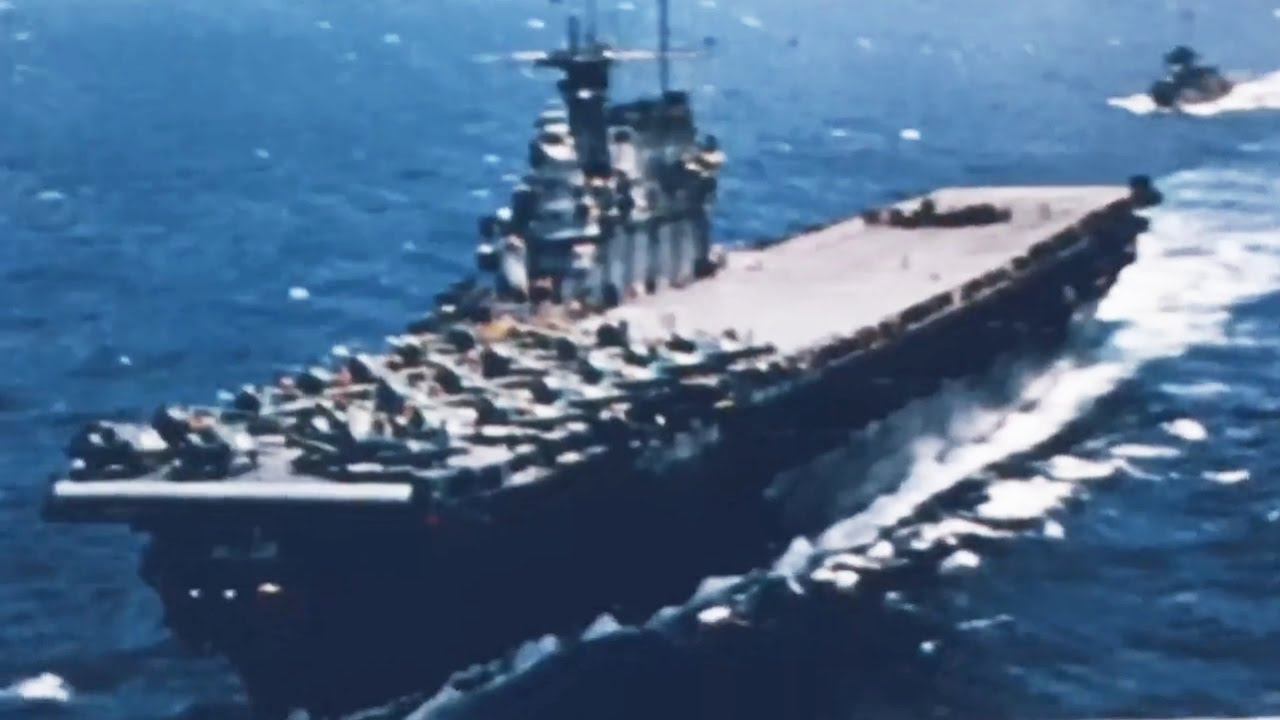World War II playlist:
Aircraft Carrier playlist:
more at
‘Made in 1942 and shot in color, “The Battle of Midway” is John Ford’s masterpiece of documentary filmmaking. Featuring voice overs by Donald Crisp, Henry Fonda, and Jane Darwell, the film includes material shot by Ford himself during the Japanese bombardment of Midway. John Ford’s handheld, 16mm footage of the battle was captured totally impromptu. He had been in transit on the island, roused from his bunk by the sounds of the battle, picked up his camera and began shooting. Ford was wounded by shrapnel from a Japanese bomb while filming. Featured in the film are many things of note, including operations of PBY Catalina flying boats as scout aircraft and to recover downed pilots, shots of the B-17s which operated off Midway during the battle, and the assault on Midway itself. At sea, the film shows the American aircraft carrier forces conducting flight operations and defending against Japanese aircraft.’
Public domain film from the US National Archives, slightly cropped to remove uneven edges, with the aspect ratio corrected, and one-pass brightness-contrast-color correction & mild video noise reduction applied.
The soundtrack was also processed with volume normalization, noise reduction, clipping reduction, and/or equalization (the resulting sound, though not perfect, is far less noisy than the original).
The Battle of Midway (Japanese: ミッドウェー海戦) is widely regarded as the most important naval battle of the Pacific Campaign of World War II. Between 4 and 7 June 1942, only six months after Japan’s attack on Pearl Harbor, and one month after the Battle of the Coral Sea, the United States Navy decisively defeated an Imperial Japanese Navy (IJN) attack against Midway Atoll, inflicting irreparable damage on the Japanese fleet. Military historian John Keegan has called it “the most stunning and decisive blow in the history of naval warfare.”
The Japanese operation, like the earlier attack on Pearl Harbor, sought to eliminate the United States as a strategic power in the Pacific, thereby giving Japan a free hand in establishing its Greater East Asia Co-Prosperity Sphere. The Japanese hoped that another demoralizing defeat would force the U.S. to capitulate in the Pacific War.
The Japanese plan was to lure the United States’ aircraft carriers into a trap. The Japanese also intended to occupy Midway Atoll as part of an overall plan to extend their defensive perimeter in response to the Doolittle Raid. This operation was also considered preparatory for further attacks against Fiji and Samoa.
The plan was handicapped by faulty Japanese assumptions of the American reaction and poor initial dispositions. Most significantly, American codebreakers were able to determine the date and location of the attack, enabling the forewarned U.S. Navy to set up an ambush of its own. Four Japanese aircraft carriers and a heavy cruiser were sunk for a cost of one American aircraft carrier and a destroyer. After Midway, and the exhausting attrition of the Solomon Islands campaign, Japan’s shipbuilding and pilot training programs were unable to keep pace in replacing their losses while the U.S. steadily increased its output in both areas…
Yamamoto’s plan, Operation Mai
Typical of Japanese naval planning during World War II, Yamamoto’s battle plan was exceedingly complex. Additionally, his design was predicated on optimistic intelligence suggesting USS Enterprise and USS Hornet, forming Task Force 16, were the only carriers available to the U.S. Pacific Fleet at the time. At the Battle of the Coral Sea just a month earlier, USS Lexington had been sunk and USS Yorktown damaged severely enough that the Japanese believed her also to have been sunk. The Japanese were also aware that USS Saratoga was undergoing repairs on the West Coast after suffering torpedo damage from a submarine.
However, more important was Yamamoto’s belief the Americans had been demoralized by their frequent defeats during the preceding six months. Yamamoto felt deception would be required to lure the U.S. fleet into a fatally compromised situation. To this end, he dispersed his forces so that their full extent (particularly his battleships) would be unlikely to be discovered by the Americans prior to battle. Critically, Yamamoto’s supporting battleships and cruisers would trail Vice-Admiral Nagumo Chūichi’s carrier striking force by several hundred miles…
Yamamoto did not know that the U.S. had broken the main Japanese naval code (dubbed JN-25 by the Americans)…

